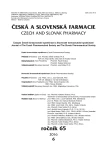Míra porozumění odborným lékařským termínům u italských studentů
:
I. Grappasonni 1; F. Petrelli 1; H. Klusoňová 2; PharmDr. Lenka Kračmarová, Ph.D. 3
:
University of Camerino, School of Pharmacy, Italy
1; Charles University in Prague, Faculty of Pharmacy in Hradec Králové, Department of Biological and Medical Sciences (in the time of study realization), Czech Republic
2; Krajská nemocnice T. Bati, a. s. – Lékárna Zlín
3
:
Čes. slov. Farm., 2016; 65, 216-220
:
Original Articles
Otázka zdravotní gramotnosti a farmakoterapie se zdá být v současné době značným problémem, obzvláště pokud povědomí o lécích je nízké. Studií, které by se zabývaly touto problematikou u studentů, není mnoho. Cílem této práce bylo zjistit míru porozumění odborným medicínským termínům u italských studentů a stanovit případnou souvislost mezi znalostí těchto termínů a věkem, pohlavím, vzděláním a zaměstnáním rodičů respondentů. Průzkum se uskutečnil formou dotazníků v regionu Marky ve střední Itálii v roce 2015. Respondenti byli náhodně vybráni mezi studenty gymnázií, odborných učilišť a místní univerzity. Následně bylo vyhodnoceno 387 vyplněných dotazníků. Míra porozumění odborným termínům mezi studenty byla poměrně nízká. Většina odborných výrazů použitých ve studii byla známá průměrně pouze pro třetinu respondentů. Byl pozorován signifikantní vztah mezi porozuměním odborným termínům a stupněm vzdělání, resp. zaměstnáním rodičů, obzvláště u výrazů, které nejsou běžně používány. Souvislost mezi znalostí medicínských termínů a pohlavím avšak zjištěna nebyla. Toto téma, zasluhující si pozornost, by mělo být dále studováno především z důvodu správné implementace preventivních zdravotnických programů.
Klíčová slova:
odborné lékařské termíny • italští studenti • správné užívání léků • rizika
Sources
1. Altin S. V., Stock S. The impact of health literacy, patient-centered communication and shared decision-making on patients’ satisfaction with care received in German primary care practices. B.M.C. Health Serv. Res. 2016; 30, 450.
2. Nair S. C., Satish K. P., Sreedharan J., Ibrahim H. Assessing health literacy in the eastern and middle-eastern cultures. B.M.C. Public Health 2016; 19, 831.
3. Palumbo R. Discussing the effects of poor health literacy on patients facing HIV: a narrative literature review. Int. J. Health Policy Manag. 2015; 4, 417–430.
4. Pharmaceutical Care Network Europe Foundation. Classification for drug related problems V6.02. 2010. http://www.pcne.org/upload/files/11_PCNE_classification_V6-2.pdf (11. 11. 2014)
5. World Health Organization. International Drug Monitoring: The role of national centres. Report of a WHO meeting. Geneva: World Health Organization 1972; 47 p.
6. The Directive 2010/84/EU of the European Parliament and of the Council of 15 December 2010. Strasbourg: Official Journal of the European Union 2010. http://ec.europa.eu/health/files/eudralex/vol-1/dir_2010_84/dir_2010_84_en.pdf (9.12.2014)
7. Walker R., Whittlesea C. Clinical pharmacy and therapeutics. 4th ed. Edinburgh: Churchill Livingstone 2007; 900.
8. World Health Organization. Health promotion glossary. Division of health promotion, education and communications (HPR) and health education and health promotion unit (HEP). Geneva: World Health Organization 1998; 24 p.
9. Scudder L. Words and well-being: how literacy affects patient health. J.N.P. 2006; 2, 28–35.
10. Chisolm D. J., Buchanan L. Measuring adolescent functional health literacy: a pilot validation of the test of functional health literacy in adults. J. Adolesc. Health. 2007; 41, 312–314.
11. Ministero della Salute. Direzione Generale del sistema informativo e statistico sanitario. http://www.salute.gov.it/portale/ documentazione/p6_2_8_1_1.jsp?id=14 (25. 6. 2013).
12. Davis T. C., Federman A. D., Bass P. F., Jackson R. H., Middlebrooks M., Parker R. M., Wolf M. S. Improving patient understanding of prescription drug label instruction. J. Gen. Intern. Med. 2008; 24, 57–62.
13. Gazmararian J. A., Williams M. V., Peel J., Baker D. W. Health literacy and knowledge of chronic disease. Patient Educ. Couns. 2003; 51, 267–275.
14. Golbeck A., Paschal A., Jones A., Hsiao T. Correlation reading comprehension and health numeracy among adults with low literacy. Patient Educ. Couns. 2011; 84, 132–134.
15. Roter D. L. Oral literacy demand of health care communication: Challenges and solutions. Nurs. Outlook 2011; 59, 79–84.
16. Ferguson L. A, Pawlak R. Health literacy: The road to improved health outcomes. J.N.P. 2011; 7, 123–129.
17. Davis T. C, Wolf M. S., Bass P. F., Middlebrooks M., Kennen E., Baker D. W., Bennett C. L., Durazo-Arvizu R., Bocchini A., Savory S., Parker R. M. Low literacy impairs comprehension of prescription drug warning labels. J. Gen. Intern. Med. 2006; 21, 847–851.
18. Bohlman L. N., Panzer A. M., Kindig D. A. Health literacy: a prescription to end confusion. Washington, DC: The National Academies Press 2004; b346 p.
19. Parikh N. S., Parker R. M., Nurss J. R., Baker D. W., Williams M. V. Shame and health literacy: the unspoken connection. Patient Educ. Couns. 1996; 27, 33–39.
20. Driessnack M., Chung S., Perkhounkova E., Hein M. Using the “Newest Vital Sign” to assess health literacy in children. J. Pediatr. Health Care 2014; 28, 165–171.
21. Connor M., Mantwill S., Schulz P. J. Functional health literacy in Switzerland – Validation of German, Italian, and French health literacy test. Patient Educ. Couns. 2013; 90, 12–17.
22. van der Heide I., Rademakers J., Schipper M., Droomers M., Sørensen K., Uiters E. Health literacy of Dutch adults: a cross sectional survey. B.M.C. Public Health 2013; 13, 179.
23. Chan F. W., Wong F. Y., So W., Kung K., Wong C. K. How much do elders with chronic conditions know about their medication? B.M.C. Geriatr. 2013; 13, 59.
24. Patel M. J., Khan M. S., Ali F., Kazmi Z., Riaz T., Awan S., Sorathia A. L. Patients‘ insight of interpreting prescriptions and drug labels – a cross sectional study. PloS One 2013; 8, e65019.
Labels
Pharmacy Clinical pharmacologyArticle was published in
Czech and Slovak Pharmacy

2016 Issue 6
Most read in this issue
- Influence of drug concentration and blending technology on the content uniformity of mixture for low dose warfarin tablets
- Fractal aspects of the flow and shear behaviour of free-flowable particle size fractions of pharmaceutical directly compressible excipient sorbitol
- Effect of EUDRAGIT® RS on the release behaviour of theophylline solid dispersions
- Level of understanding of medical terms among italian students
